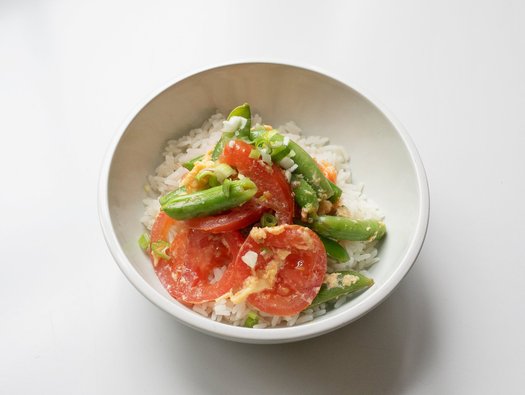Stir-fried tomato with egg

An authentic, flavourful, low-salt dish that’s filling and quick to prepare.

An authentic, flavourful, low-salt dish that’s filling and quick to prepare.
300g rice
4 eggs
Pinch of white pepper
1 teaspoon vegetable oil
4 fresh medium tomatoes sliced or a 400g tin of tomatoes
200g sugar snap peas
1 teaspoon reduced-salt soy sauce
1 ½ tablespoons sugar
1 teaspoon minced garlic (optional)
1 spring onion, diced (optional)
Cook the rice according to the packet instructions.
Whisk the eggs and white pepper together in a bowl, until well beaten.
Add the oil to a frying pan on a medium heat. Add the tomatoes and sugar snap peas. Stir-fry them until they are softened.
Add the sugar and soy sauce to the pan and stir-fry for a few minutes.
Add the well-beaten eggs and half of the diced spring onion to the pan. Stir-fry them gently until the egg is cooked through.
Serve with the rice and top with the remaining spring onion.
The rice is the main source of carbohydrate in this recipe, and the value has been provided for those who have been trained in insulin adjustment.
This recipe is low in potassium, despite the use of tomatoes, a high potassium vegetable. This is because the quantities have been kept to a minimum, therefore please ensure you follow the quantities for all the ingredients and the serving sizes.
This recipe is also low in phosphate, however it still contains phosphate, provided by the egg and rice, therefore, if you are prescribed a phosphate binder you should take as directed.
This recipe is low in protein, which makes it suitable for those advised to eat less protein.
Use a gluten-free soy sauce, such as Tamari.
To increase the fibre of this dish, consider using a wholegrain brown rice in place of a white rice. Despite the soy sauce chosen being a reduced-salt version, it is still high in salt, therefore it is recommended you measure the soy sauce carefully to avoid adding additional salt.
This dish is best eaten fresh.
By giving us your email address, you're giving us permission to send you the latest news from Kidney Care UK. Further information about how we protect and use your personal data is available in our Privacy policy. If you would like to change the way we communicate with you at any time please email [email protected]. You can unsubscribe at any time by using the link at the bottom of every email we send.